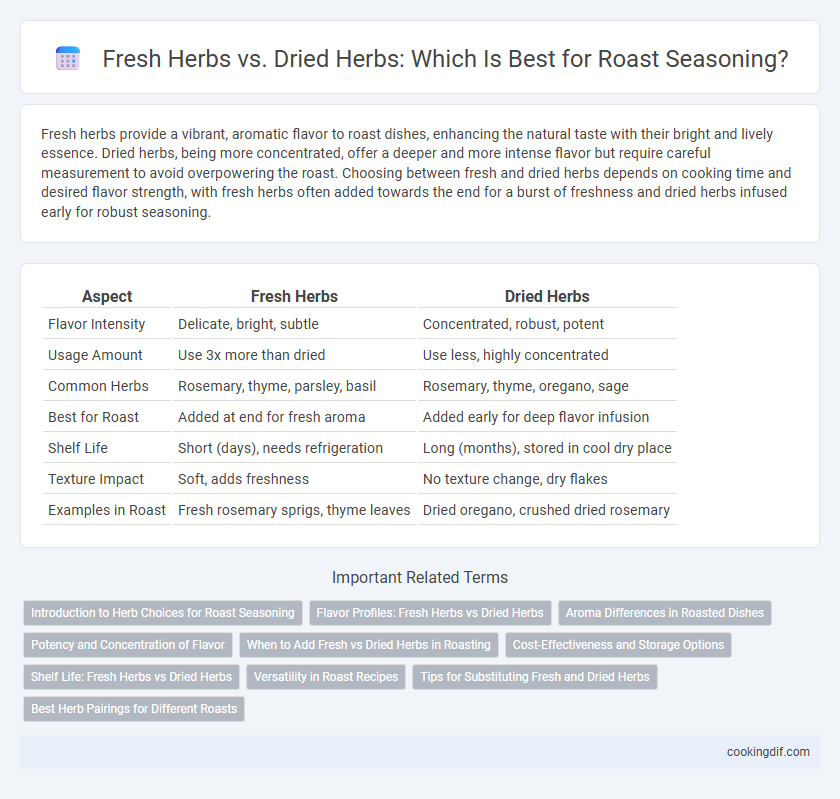Fresh herbs provide a vibrant, aromatic flavor to roast dishes, enhancing the natural taste with their bright and lively essence. Dried herbs, being more concentrated, offer a deeper and more intense flavor but require careful measurement to avoid overpowering the roast. Choosing between fresh and dried herbs depends on cooking time and desired flavor strength, with fresh herbs often added towards the end for a burst of freshness and dried herbs infused early for robust seasoning.
Table of Comparison
| Aspect | Fresh Herbs | Dried Herbs |
|---|---|---|
| Flavor Intensity | Delicate, bright, subtle | Concentrated, robust, potent |
| Usage Amount | Use 3x more than dried | Use less, highly concentrated |
| Common Herbs | Rosemary, thyme, parsley, basil | Rosemary, thyme, oregano, sage |
| Best for Roast | Added at end for fresh aroma | Added early for deep flavor infusion |
| Shelf Life | Short (days), needs refrigeration | Long (months), stored in cool dry place |
| Texture Impact | Soft, adds freshness | No texture change, dry flakes |
| Examples in Roast | Fresh rosemary sprigs, thyme leaves | Dried oregano, crushed dried rosemary |
Introduction to Herb Choices for Roast Seasoning
Fresh herbs, such as rosemary, thyme, and sage, offer vibrant flavors and aromatic oils that enhance the natural taste of roast dishes. Dried herbs concentrate flavor intensity, making them ideal for long cooking times where their potency infuses deeply into the meat. Choosing between fresh and dried herbs depends on the desired flavor profile, cooking duration, and texture preferences in roast seasoning.
Flavor Profiles: Fresh Herbs vs Dried Herbs
Fresh herbs provide vibrant, bright flavors with subtle, aromatic notes that can enhance the complexity of a roast without overpowering it. Dried herbs, being more concentrated, deliver a deeper, more intense flavor that infuses slowly during roasting, intensifying the seasoning over time. The choice between fresh and dried herbs depends on the desired flavor intensity and cooking duration, with fresh herbs ideal for finishing and dried herbs best suited for longer roasting processes.
Aroma Differences in Roasted Dishes
Fresh herbs release vibrant, nuanced aromas during roasting, enhancing the dish with bright, herbaceous notes that complement the natural flavors of roasted meats and vegetables. Dried herbs concentrate their essential oils, producing a deeper, more intense fragrance but sometimes lacking the fresh, green quality present in fresh varieties. Using fresh herbs like rosemary or thyme just before roasting preserves their aromatic oils, whereas dried herbs infuse a robust, earthy scent throughout the cooking process.
Potency and Concentration of Flavor
Dried herbs offer a more concentrated and potent flavor for roast seasoning due to the removal of moisture, intensifying their essential oils and aromatic compounds. Fresh herbs provide a milder, more subtle flavor that can complement a roast without overpowering it, but often require larger quantities to achieve the same impact as dried herbs. For robust roast seasoning, dried herbs are preferred to maximize flavor potency and longevity during cooking.
When to Add Fresh vs Dried Herbs in Roasting
Fresh herbs such as rosemary, thyme, and parsley release vibrant flavors when added toward the end of roasting, preserving their delicate aromas and preventing bitterness. Dried herbs, concentrated and robust, are best incorporated earlier in the roasting process to allow their flavors to infuse deeply into meats or vegetables. Timing the addition of fresh versus dried herbs optimizes the seasoning impact, enhancing the roast with balanced, layered herbal notes.
Cost-Effectiveness and Storage Options
Dried herbs offer superior cost-effectiveness for roast seasoning due to their extended shelf life, typically lasting one to three years when stored in a cool, dark place. Fresh herbs, while providing vibrant flavors, require immediate use and refrigeration, leading to higher long-term costs and increased waste. Proper storage of dried herbs in airtight containers maximizes potency and reduces the need for frequent repurchasing compared to the perishable nature of fresh herbs.
Shelf Life: Fresh Herbs vs Dried Herbs
Fresh herbs offer vibrant flavors but have a limited shelf life, typically lasting only 3 to 7 days when stored properly in the refrigerator. Dried herbs, on the other hand, retain their potency for 1 to 3 years if kept in a cool, dark place, making them ideal for long-term storage and consistent seasoning. Choosing between fresh and dried herbs for roast seasoning depends on the balance between immediate freshness and extended shelf stability.
Versatility in Roast Recipes
Fresh herbs offer vibrant flavor and aroma that can enhance the natural juices of a roast, making them ideal for recipes requiring subtle, bright notes. Dried herbs provide concentrated taste and longer shelf life, allowing for deeper infusion during slow roasting processes. Combining fresh and dried herbs maximizes versatility, balancing freshness with intensity to suit various roast styles and seasoning preferences.
Tips for Substituting Fresh and Dried Herbs
When substituting fresh herbs with dried herbs for roast seasoning, use one-third the quantity since dried herbs have a more concentrated flavor. For optimal results, add dried herbs early in the cooking process to allow their flavors to infuse the roast, while fresh herbs are best added towards the end for a vibrant, aromatic finish. Common herbs like rosemary, thyme, and oregano retain their potency when dried, making them ideal for seasoning roasts.
Best Herb Pairings for Different Roasts
Fresh herbs like rosemary, thyme, and sage provide vibrant, aromatic flavors that complement beef, lamb, and pork roasts, enhancing their natural richness. Dried herbs such as oregano, marjoram, and bay leaves release concentrated flavors ideal for slow-cooked roasts like pot roast or braised meats, where longer cooking times mellow and intensify their essence. Combining fresh rosemary and thyme with dried oregano or bay leaves creates a balanced herb blend that elevates the complexity of varied roast dishes.
Fresh Herbs vs Dried Herbs for roast seasoning Infographic

 cookingdif.com
cookingdif.com